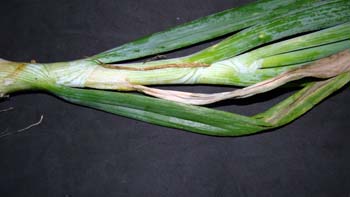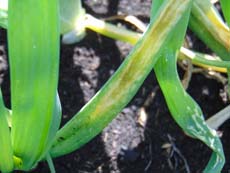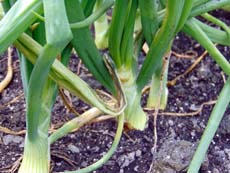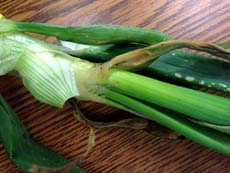Newly identified bacterial disease on onions
Be on the alert for bacterial diseases such as bacterial leaf blight in your onion fields.

Bacterial diseases of onion were a limiting factor for yields in 2012 for growers in Allegan and Ottawa counties. Bacterial leaf blight (Pantoea agglomerans) and bacterial center rot (Pantoea ananatis) were isolated from 85 samples of onions from both counties. P. ananatis was recovered from 25 samples collected in Ottawa County and 60 samples were infected with P. agglomerans from fields in Allegan County. Both pathogens could have contributed to the rot of the onion bulb before harvest and during storage. Previously in 2011, a major onion grower suffered nearly total loss from a bacterial rot diagnosed as bacterial leaf blight (P. agglomerans).
P. agglomerans is considered a new pathogen for onions in the United States and was reported by pathologists in Georgia in 2006. Since that time, pathologists in New York and Pennsylvania have also observed the disease in their states. It appears that 2011 may be the earliest verified report that we have of P. agglomerans from Michigan onions. In 2013, P. agglomerans was identified again in Michigan with the assistance of Michigan State University graduate students Prissana Wiriyajitsomboon and Kim Eang Tho and the diagnostic resources available through Jan Byrne in MSU Diagnostic Services.
This year (2014), the bacterial leaf blight pathogen has been detected earlier than before in multiple onion fields across several Michigan counties. Fields across the onion-growing area were scouted and sampled with fields in Hudsonville, Hamilton, Marshall, Stockbridge, Charlotte and Grant, Michigan, showing similar leaf symptoms of bacterial infection. A report from Cornell pathologists indicates that this bacterial leaf pathogen can result in bulb rot. Previously, Michigan onion growers have experienced bacterial rot late in the growing season and then in storage, and in the last couple of years, the bacterium P. agglomerans has been consistently isolated from symptomatic leaves (see photos directly below). In one situation, this pathogen was isolated even from leaves that were browned and withered from bulbs already placed in storage.


Onions with bacterial disease sampled from growers’ fields.
Warm, humid and wet weather favors outbreaks of bacterial diseases and drives rapid increases of the bacterial cells in plant tissues. On other crops that suffer from bacterial diseases, only early applications of bactericides can reduce bacterial numbers low enough to prevent symptom development. It is not clear at this time whether copper-based products can reduce bacterial leaf blight of onion. When symptoms including water-soaked or brown tissue are observed on the onion leaves, it is generally too late to achieve control of bacterial diseases.
It is possible that the bacteria can be washed down into the neck and bulb region of the onion and cause rotted and mushy tissue at the top of the bulb. This infection could then spread to the scales of the onion bulb and cause a primary infection. It is common that once the onion bulb is compromised with the first bacterial infection that a secondary infection by other bacteria can occur and accelerate rotting. Infected bulbs are unmarketable and cannot be stored successfully.



Left, Leaf lesion due to bacterial infection. Middle, Shriveling of leaves due to bacterial infection. Right, Soft rot of leaves due to bacterial infection.



 Print
Print Email
Email


